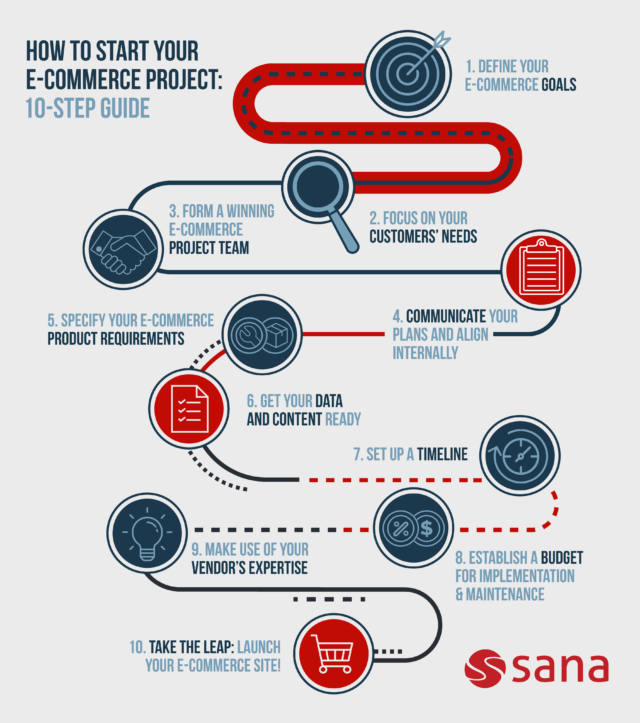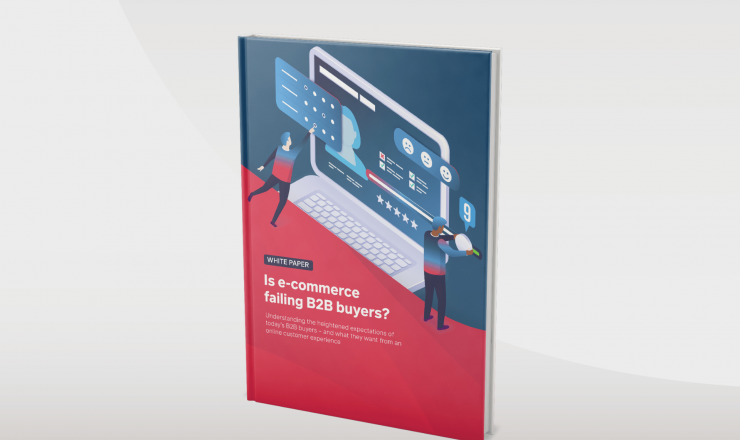

Discover everything you need to know and do to start your B2B e-commerce project. This step-by-step guide is ideal if you’re implementing your first e-commerce website. But it’s also a useful reminder checklist if you’re about to start a replatforming project for your current online store.
Whether you are a small business or a large company, every successful B2B e-commerce implementation starts with the following 10 steps. These are based on the combined expertise and experience of our Project, Sales and Customer Success Managers, here at Sana Commerce. Read on to see exactly what makes a successful e-commerce project plan, and what is the best way to start your e-commerce website.
With the right plan and preparation, nothing stands in the way of a successful e-commerce website launch on time and on budget!
For more checklists and best practices to steer you through your entire e-commerce project — from planning to going live — download our Ultimate Guide to E-Commerce.
1. Start by defining your e-commerce goals
Before you dive into your e-commerce project, consider why you want to start a web store in the first place. Hint: it shouldn’t just be because your competition has one!
The best way to start your e-commerce project is to determine your business needs and goals. Do this by asking yourself questions such as: Why do I want to start an e-commerce website now? What are the business advantages? What do I want to achieve by starting an online store? What does e-commerce success look like to my company? How does it fit into my overall company strategy?
Example e-commerce goals include:
- Increasing revenue and/or number of customers
- Freeing up time for your sales and support teams
- Lowering overhead costs
- Increasing the efficiency of the ordering process and reducing order errors
- Improving your customer experience
Now that you know what you want to achieve, consider also how you want to achieve it: define your e-commerce strategy. Consider who you want to sell to, what you want to sell online, whether you want to expand to new markets (e.g. B2B2C), etc.
Finally, set clear e-commerce KPIs (key performance indicators) that align with your goals and strategy. Having clear KPIs ensures that you can measure the success of your e-commerce website project and spot any gaps that require your attention — while also ensuring there is a continuous focus on your e-commerce goals. Example KPIs include: percentage of orders taken through the web store, average order value and percentage decrease in order errors. Discover more B2B e-commerce KPIs for online sales.
“E-commerce is most successful not just when it aligns with your overall company strategy, but when it is part of your overall strategy.”
— Jacco Hop | Manager Pre-Sales at Sana Commerce
2. Focus on your B2B customers’ needs
It’s not just your own business goals that you need to take into consideration when you start with e-commerce, but also those of your customers. The success of your online store relies on their shopping needs and experience. Your customers will only use your web store if it suits them. It is therefore imperative to build your e-commerce plans around your customers. This means knowing what they are looking for and what they expect, and delivering against these requirements.
Put yourself in your customers’ shoes: What do they need? How do they buy products? What experience do they expect? Their priorities could vary widely from accessing real-time information 24/7, to the ability of selecting existing payment agreements in the web store, or even transparency on order status and delivery updates.
Of course, the best way to find out what your customers want is to go out there and ask them. Start with your biggest customers. But be sure to also include a good mix of customers who are big advocates of B2B web stores, as well as those who are skeptical about ordering online. Then, see if you can find some common ground between all these varying needs. Find out more about capturing B2B customer feedback.

Do you know what your B2B clients want?
Get the full insights from our B2B Buyer Report.
3. Form a winning e-commerce project team
Put someone in charge of e-commerce
Before you start your e-commerce implementation, you need to appoint an E-Commerce Manager: someone who takes charge of your e-commerce project, plan and team. This person should have KPIs relating to e-commerce success and adoption goals. They should have the authority to make decisions and the skills to move the project forward, including the ability to get people together and move them in the same direction.
For smaller businesses, this does not necessarily mean someone dedicated to e-commerce on a full-time basis. But you do need one person to take responsibility for the launch and running of your online store.

Gather team members from different departments
Your E-Commerce Manager should then involve stakeholders from other departments to form an e-commerce team. Since e-commerce touches so many, if not all parts of your organization, you need to involve people from every department to bring the necessary knowledge and skills to the table. All members of the team should understand how e-commerce can help their respective departments, and how they can contribute to achieving e-commerce success.
Depending on whether you are a large, enterprise company or a small to medium-sized business (SMB or SME), your e-commerce project team can take various shapes. Large companies tend to form internal multidisciplinary project teams. These teams not only carry out the e-commerce project, but also include all the supporting roles needed to run an e-commerce website. On the other hand, small businesses can find it harder to dedicate entire resources to this kind of project. We often find that team members work on the e-commerce website project alongside their current responsibilities. But as long as the e-commerce project is taken seriously, with the right resources attributed, then both methods can lead to successful results.
Read our full article on building a successful e-commerce team.
Get your directors on board with your e-commerce implementation
Something we see with our most successful customers is that their directors or senior management are on board with their e-commerce project plans and understand the work that is required. Indeed, e-commerce is most successful when you make it part of your broader company strategy. This means that you need to have commitment from the top. Ideally, your e-commerce team should also have the mandate from management to make decisions throughout each stage of your e-commerce project, to avoid any delays to the launch.

Quantify the value of e-commerce for your business
Use our free ROI calculator.
4. Communicate your e-commerce plans and align internally
To ensure your e-commerce project is a success, internal support and alignment are key. Make sure your entire organization is on board with your e-commerce plans and understands the benefits. Ideally, you want to involve each department and stakeholder from the planning phases, to ensure everyone feels heard from the start of your e-commerce implementation.
Change often causes concern and resistance. So, it is your responsibility to educate each department on the advantages of e-commerce, highlighting benefits relevant to each stakeholder. Will it increase your revenue? Will it help you reach new markets? Will it help IT processes run smoother and with fewer errors? Will it free up your sales and support teams’ time so they can focus on your biggest deals and clients? In short, communicate what’s in it for them and establish common goals.
Get more tips on how to overcome internal resistance to launching a web store.
And don’t forget any external stakeholders! Perhaps you have an external ERP or hosting partner? Or you work with an external IT or design agency? Make sure to align with them too on your e-commerce plans and goals.
“Our most successful customers align everything internally and externally. They have a dedicated person in the lead who has the mandate of management and the skills to get people together. And they started doing: they didn’t keep talking, they acted.”
— Robert Pennings | Customer Success Manager at Sana Commerce

5. Specify your e-commerce product requirements (MVP)
Think about what you want from your e-commerce web store. Start first by establishing your must-haves. That is, think about the minimum features and functions needed to satisfy you and your customers: your minimum viable product (MVP). Only after this, if time and budget allow, should you start thinking about any additional nice-to-haves.
When defining your e-commerce MVP, consider the following:
- Ensure it aligns with your e-commerce goals.
- Only include features and functions that you plan to use within the first year of your e-commerce website launch.
- Ensure it addresses the most common questions you get from your customers.
- Be realistic about how much you can accomplish with your internal resources. For example, if you want a video content feature, check first that you have the capabilities and resources internally (or the means to hire an external agency) to create this video content.
- Understand and make the most of the functions and features your chosen e-commerce platform delivers as standard, before looking into more costly and complex customizations.
Once you launch your first e-commerce MVP, you can start testing it and gathering internal and customer feedback. Only then will you know which additional functions and customizations are really needed, and which ones you can do without.
Guide your product requirements with e-commerce user stories
One way to develop a comprehensive e-commerce MVP is by using e-commerce user stories. User stories help you define the different steps and journeys users might take on your online store. They are written from your web store users’ point of view, which will include your customers, but also any sales or support teams who might also use the web store. And they should be split into the smallest steps possible.
The number of e-commerce user stories you need will vary depending on the scope of your project. If you don’t let your customers pay online, then you don’t need a user story for this. But if you want to be able to send quotes to customers, allow them to track their shipping, or enable sales reps to order via your web store, then you need to create user stories for all these journeys.
Once you have created your user stories, ensure you translate these into e-commerce features and functions that meet the needs of each user. Think about making sure your web store users can easily accomplish each step. E-commerce user stories also make wonderful guidelines when it comes to testing your website, as you’ve already identified each customer flow that will need to be tested.

Map your customer journey with user stories
Learn how with our easy to follow template and examples.
6. Get your data and content ready for your e-commerce website
Companies starting with their first e-commerce website often underestimate content. From product and company descriptions and images, to web store look-and-feel, structure and categories, a lot of content is needed before you can launch your e-commerce website.
So, you need to be prepared to structure and fill your web store. Think about what products you are going to sell. Decide what the structure, main categories and subcategories will be. Check that you have an image for each product, and that these images are of good-enough quality. Perhaps you also need to create some technical materials, for example, that your customers will need to install your products.
If you choose an e-commerce platform that is directly integrated with your ERP system and/or PIM solution, you can automatically display the product descriptions and images that are already stored in your existing systems on your web store — saving you valuable time. However, this still requires you to clean up your ERP data or PIM content, ensuring, for example, that all the product names you use are clear and usable on a customer-facing web store.

7. Set up a timeline for your e-commerce project
How long will my e-commerce project take?
An e-commerce project timeline can be difficult to predict, especially if this is your first e-commerce website. The timeline depends both on your vendor and the solution you choose, as well as the time it takes you internally to configure your online store.
With our out-of-the-box Sana Commerce product, we find that 2 to 3 months between buying and going live with e-commerce is a realistic estimate. This includes the implementation of the web store, as well as configuration by the customer. But any additional customizations need to be evaluated individually. If you factor in the time it takes you to do your research, specify your requirements and approach e-commerce vendors, we find that a total of 9 months from investigation to launch of your e-commerce website is a reasonable timeline.
On top of customizations, several other factors can influence the speed of your e-commerce project timeline (both positively and negatively), including factors which you can control internally. The two factors which we find most impact the launch date are the decision-making process and your available internal resources:
The decision-making process
The decision-making process is often what makes e-commerce implementation timelines overrun. Especially in the last phase of e-commerce projects, when it comes to the finer details, there’s always a lot of discussions and delayed decisions. Some companies also have strict processes in place that means that every decision needs to go through legal or procurement departments, which can slow the e-commerce implementation process.
How can you overcome this? As touched on previously, to avoid any delays in the launch of your e-commerce website, make sure the people involved in your e-commerce project have the mandate to make decisions. Ensure they have the authority from senior management to sign off and keep the project moving forward.
Your internal resources
Another key factor that can delay or speed up the launch of your e-commerce website is the time it takes you to get ready internally. During the e-commerce project phase, it is your internal resources that will have to create the content for your website. So, factor time in for this. You’ll need dedicated resources with clear responsibilities and the right technical, product and content knowledge. And don’t expect that your employees can do this beside their current workload, as other things will be given priority, delaying your e-commerce website implementation.
Defining milestones and creating a project roadmap is a great way to keep track of your e-commerce project. It helps you ensure you keep moving forward, while also pinpointing any hurdles that you need to address.

Do you know what your buyers want in 2025?
We do. Get our latest report to learn what buyers want and how to meet their e-commerce expectations in 2025.
8. Establish the right budget for your B2B e-commerce implementation and maintenance
How much does an e-commerce website cost? There is, of course, no set answer to this question. Some basic platforms are free to use, while others can run into the millions of dollars. So it all depends on your business requirements. But whatever you choose, you should always consider your total cost of ownership (TCO).
“If you win the lottery and receive $1m, you shouldn’t buy a house for that full amount. You have to set funds aside to maintain your house, pay property taxes, hire a gardener etc. The same goes for your e-commerce platform.”
— Robert Pennings | Customer Success Manager at Sana Commerce
Make sure you look ahead to create a realistic e-commerce budget for the future. You should of course take into account the cost of the initial e-commerce platform implementation. But you should also factor in any licensing and maintenance costs, as well as ERP partner, design or content agency fees — if you don’t have the resources internally.
And it’s not just about hard cash. Think also about the internal resources you will need to launch and run your e-commerce platform. They also cost money. How many internal resources you need to set aside will vary based on your business and your chosen e-commerce platform. For example, some platforms are more automated than others. So, while with one platform you might need an entire team of people to manually process orders, with another this process will be automated, saving on resources (one of the key benefits of ERP-integrated e-commerce!)
Learn more about calculating e-commerce costs and the expenses that could push you over budget.
9. Make use of your vendor’s e-commerce project expertise
Your chosen e-commerce software provider is likely to have extensive experience in B2B e-commerce implementation projects. They also know what successful and unsuccessful projects look like. So, make full use of this expertise!
How should I get started with e-commerce? How long does a typical B2B e-commerce project take? What budget should I set aside for my e-commerce website? Who should be in my e-commerce team? How do I get my online content ready? What do your most successful customers have in common? These are all questions your e-commerce provider should be able to help you with. So, make sure to ask for tailored advice at every stage of your e-commerce project.
For example, at Sana Commerce, we have a customer onboarding program to help make the e-commerce preparation stage as smooth as possible. This includes information on how to form a project team and how you should format your content; documentation such as user stories, RFPs and more templates; an overview of the total cost of ownership (TCO), but also assistance with estimating the cost of your marketing budget and internal resources — to help you get started with e-commerce and ensure your project is a success.
We also offer lots of online resources such as blog posts, white papers, factsheets and our customers’ e-commerce stories to inspire your own.
“Dedication makes all the difference to the success of an e-commerce project. My most successful customers have a dedicated project team and internal resources, clear goals and responsibilities, and an established time frame.”
— Melanie Volkmann | Project Manager at Sana Commerce

10. Take the leap: Launch your e-commerce site!
However much you prepare for your e-commerce implementation, you can never know or foresee everything. As with most things in life, there is no perfect. There comes a point when you have to just go. So, choose a software provider. Prepare well. But then make the decision to go live with your e-commerce implementation. Once live, you can learn, test and continuously optimize your web store as your knowledge and experience grows.
“Sana Commerce is best for midmarket
manufacturing or wholesale companies that run
SAP or Microsoft Dynamics ERPs.”
More useful resources and guides for your e-commerce project
Ready to get started with e-commerce? We’ve created some useful guides and templates to help you kick start your e-commerce project:
- Ask potential vendors all the right questions by downloading our B2B e-commerce RFP template, which comes complete with a handy vendor rating system.
- Use our e-commerce ROI calculator to quantify the value of e-commerce for your business, and inform your business case.
- Create user stories for your e-commerce website with our template and example stories.
Plus, learn more about how to select the best e-commerce solution provider in our blog post, and use our e-commerce software vendor decision-making flowchart to determine which solution best fits your business.

E-commerce project: From planning to going live
Get our ultimate guide to e-commerce now.



